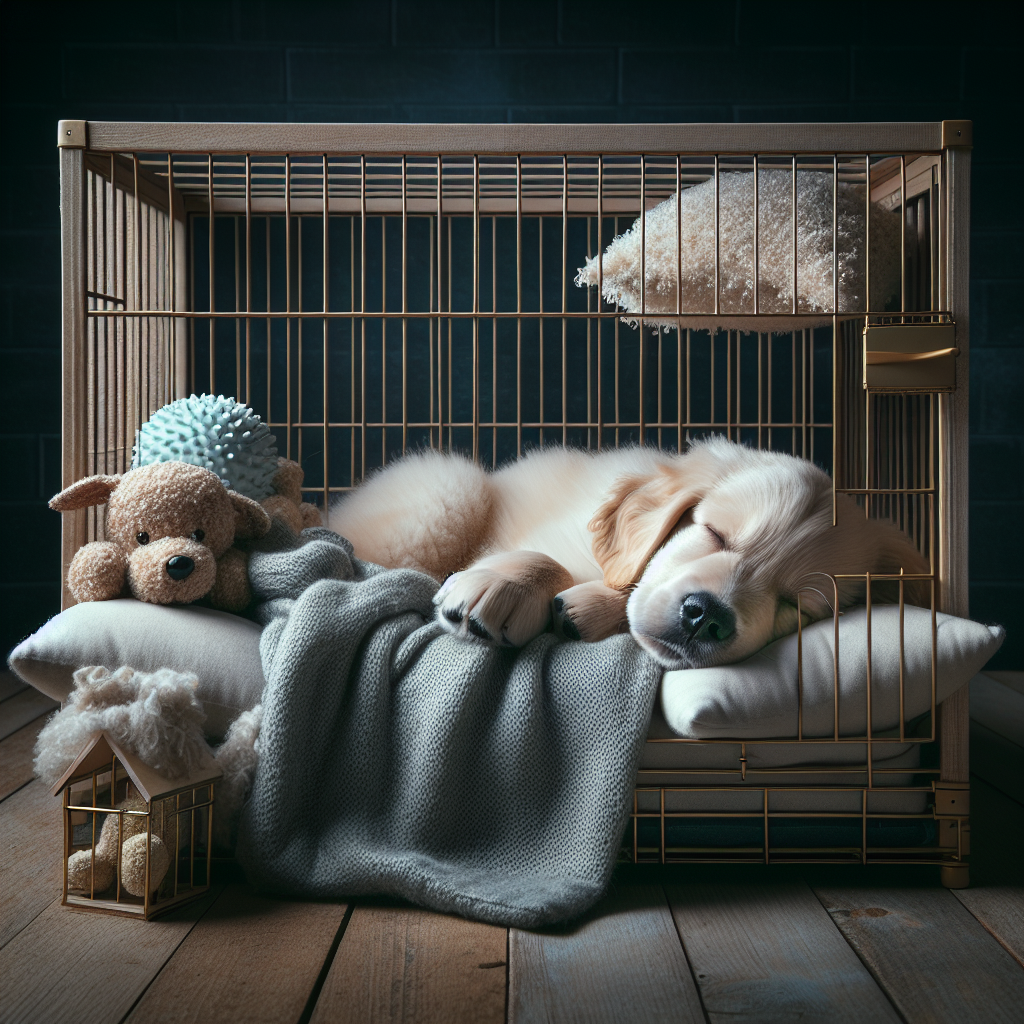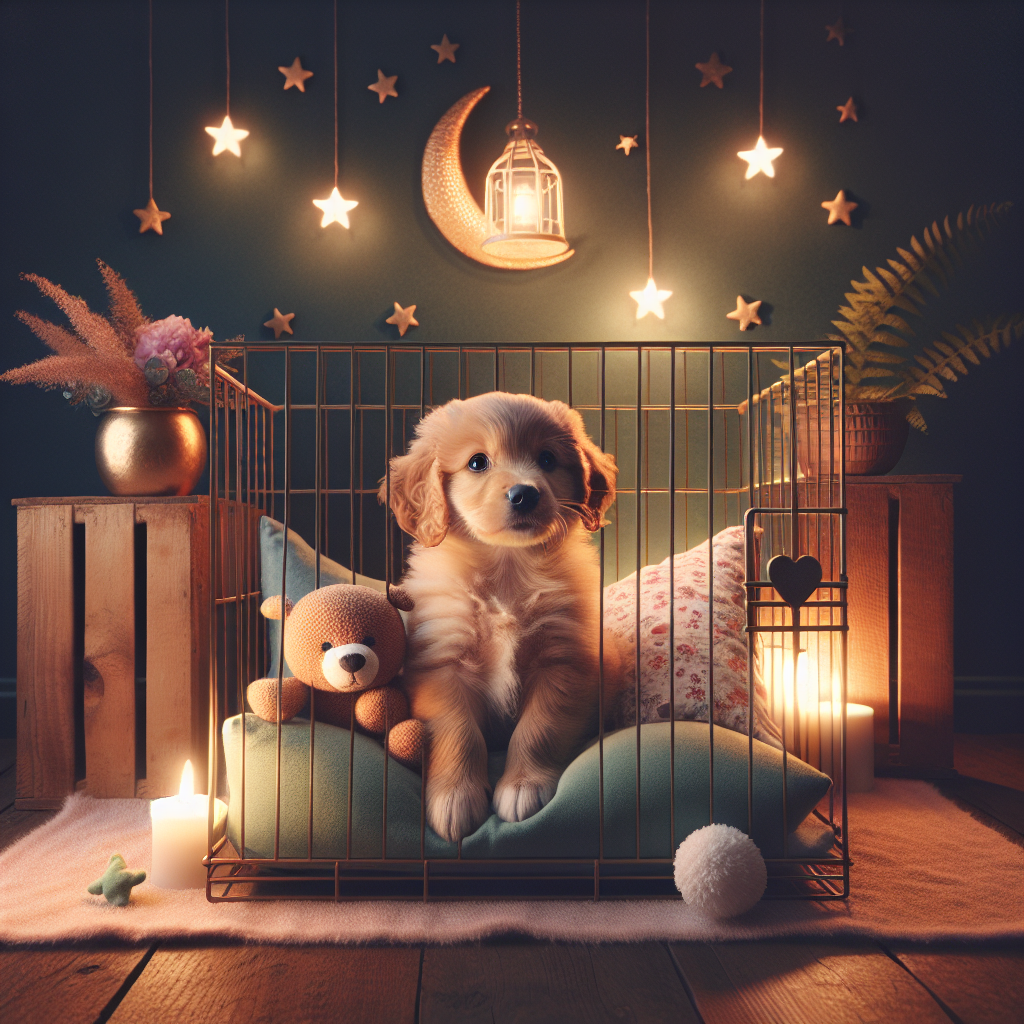So you’ve brought home a new furry friend and now you’re faced with the challenge of crate training them at night. Don’t worry, we’ve got you covered! In this article, we’ll guide you through the steps to successfully crate train your puppy at night. From creating a comfortable space to helping them feel secure, we’ll provide you with all the tips and tricks you need to ensure a peaceful and restful night for both you and your four-legged companion. Say goodbye to those sleepless nights and hello to a well-rested and happy puppy!
Selecting the Right Crate
Choosing the crate size
When it comes to crate training your puppy at night, one of the first things you need to consider is the size of the crate. The crate should be just big enough for your puppy to stand up, turn around, and lie down comfortably. If the crate is too big, your puppy may be more inclined to use one end as a bathroom and sleep in the other. Therefore, it’s important to select a crate that is appropriate for your puppy’s current size, with some room for growth.
Considering the crate material
When selecting a crate for nighttime crate training, you have a few options for materials. The most common types of crates are made of wire or plastic. Wire crates offer better ventilation and visibility, allowing your puppy to feel less isolated. On the other hand, plastic crates can provide a den-like environment, which can make some puppies feel more secure. Think about your puppy’s temperament and preferences when choosing the right material for their crate.
Determining crate location
The location of the crate plays a crucial role in the success of nighttime crate training. You want to place the crate in an area of your home that is calm and quiet, away from high-traffic areas and loud noises. It’s also important to keep your puppy within sight and earshot, as being too far away may cause them to feel anxious or isolated. Consider placing the crate in your bedroom initially, as this can provide a sense of security for your puppy during the night.
Preparing the Crate Environment
Making the crate comfortable
Creating a comfortable environment within the crate is essential for ensuring your puppy feels safe and secure. Line the bottom of the crate with soft bedding, such as a blanket or towel, to provide a cozy surface for your puppy to rest on. However, be cautious of using materials that your puppy may chew on and accidentally ingest. It’s best to avoid using stuffing or pillows that could pose a choking hazard.
Introducing the crate gradually
To help your puppy feel more comfortable in the crate, it’s important to introduce it gradually. Start by leaving the crate door open and allowing your puppy to explore it at their own pace. You can place treats or toys inside the crate to encourage positive associations. Additionally, feeding your puppy their meals near the crate or placing their favorite toys near it can help create a positive association with the crate.
Using positive reinforcement
Positive reinforcement is a powerful tool when crate training your puppy at night. Whenever your puppy willingly enters the crate or exhibits calm behavior inside, reward them with praise and treats. By associating positive experiences with the crate, you are helping them build a positive and comfortable relationship with their sleeping space. This positive reinforcement will encourage your puppy to view the crate as a safe and enjoyable place to sleep.

This image is property of pixabay.com.
Establishing a Bedtime Routine
Setting a consistent bedtime
Consistency is key when crate training a puppy at night. Establishing a consistent bedtime helps regulate your puppy’s sleep patterns and prevents confusion. Determine a bedtime that works best for both you and your puppy’s needs and stick to it. By having a predictable schedule, your puppy will begin to anticipate sleep time and be more willing to settle into their crate for the night.
Establishing a pre-bedtime routine
A pre-bedtime routine can help signal to your puppy that it’s time to wind down and prepare for sleep. This routine can include activities such as a short walk, gentle playtime, or some calming cuddles. By engaging in these calming activities before bedtime, you are helping your puppy transition from an active state to a more relaxed one. This routine can also serve as a bonding time for you and your furry friend.
Encouraging calm activities before bed
Before settling your puppy into their crate for the night, it’s important to engage in calm activities. Avoid stimulating play or feeding them a large meal right before bedtime, as this may increase their energy levels or stimulate their digestion. Instead, focus on gentle activities such as gentle petting, offering a chew toy, or practicing some basic obedience commands to reinforce a calm and relaxed state.
Setting Up a Potty Schedule
Understanding a puppy’s typical bladder capacity
Puppies have small bladders and need to relieve themselves more frequently compared to adult dogs. Understanding your puppy’s typical bladder capacity will help you establish an appropriate potty schedule. On average, a puppy can hold their bladder for approximately one hour for every month of age. However, keep in mind that every puppy is different, and some may have smaller or larger bladder capacities than others.
Establishing regular potty breaks
It’s important to establish a regular potty schedule for your puppy, even during crate training at night. Take your puppy outside to their designated potty spot immediately before putting them in the crate for the night. Make sure to praise and reward them when they eliminate outside. Throughout the night, plan for regular potty breaks based on your puppy’s age and bladder capacity. Remember to keep these potty breaks simple and business-like to encourage a quick return to sleep.
Using the crate as a potty training tool
Crate training can be a useful tool in potty training your puppy at night. Puppies have a natural instinct to keep their sleeping area clean, making the crate an effective way to prevent accidents during the night. However, keep in mind that puppies have limited bladder control, so it’s essential to stick to a regular potty schedule. Avoid leaving your puppy in the crate for extended periods beyond their age-appropriate bladder capacity.

Implementing the Crate Training Process
Introducing the puppy to the crate with positive associations
To create a positive association with the crate, introduce your puppy gradually. Begin by enticing them with treats or toys and encourage them to explore the crate voluntarily. Avoid forcing the puppy into the crate or using it as a form of punishment. The goal is to make the crate a safe and inviting space for your puppy, where they feel comfortable and secure.
Using treats and rewards to encourage crate time
Treats and rewards are powerful tools when it comes to crate training your puppy at night. Use high-value treats or special toys that your puppy loves to provide positive reinforcement for spending time in the crate. Whenever your puppy willingly enters the crate, reward them immediately with praise and treats. This positive association will strengthen their willingness to use the crate as their sleeping space.
Gradually increasing crate time duration
During the initial stages of crate training, it’s important to gradually increase the duration of time your puppy spends in the crate. Start with short periods of time, such as a few minutes, and gradually increase it over time. Make sure to provide your puppy with plenty of mental and physical stimulation outside of the crate to prevent boredom. As your puppy becomes more comfortable with longer crate stays, they will gradually adjust to spending the entire night in their crate.
Addressing Nighttime Anxiety
Identifying signs of anxiety or distress
While crate training, it’s crucial to pay attention to signs of anxiety or distress your puppy may exhibit at night. These signs may include excessive whining, barking, panting, pacing, or attempts to escape the crate. Recognizing these behaviors will help you address and alleviate any anxiety or discomfort your puppy may be experiencing.
Using calming techniques
If your puppy is showing signs of anxiety or distress in their crate at night, employing calming techniques can be helpful. Some effective techniques include covering the crate with a light blanket to create a cozy den-like environment, using a white noise machine or calming music to drown out external noises, or providing a comforting item such as a stuffed toy or an article of clothing with your scent. These methods can help create a soothing atmosphere for your puppy.
Avoiding reinforcing anxious behavior
While it’s important to provide comfort and support to a puppy experiencing nighttime anxiety, it’s equally important to avoid reinforcing anxious behavior. Avoid letting your puppy out of the crate when they are whining or barking excessively, as this may teach them that those behaviors lead to freedom. Instead, wait for a moment of calm before opening the crate door, and reward your puppy for quiet and calm behavior. This will help encourage a sense of security and discourage anxious behaviors.

Promoting Positive Sleep Associations
Using cues to signal nighttime sleep
Developing cues that signal nighttime sleep can be beneficial for crate training your puppy. Dimming the lights, closing curtains, and using low, soothing voices can help create a peaceful atmosphere. You can also establish a consistent phrase or command, such as “bedtime” or “time to sleep,” to signal to your puppy that it’s time to settle down for the night. Consistency with these cues will help your puppy understand when it’s time to sleep and encourage them to enter their crate willingly.
Creating a cozy sleep environment
Creating a cozy sleep environment within the crate is important for promoting positive sleep associations. Ensure that the crate is well-padded with comfortable bedding and add a soft blanket or a snuggle toy to simulate the warmth and comfort of being with their littermates. It’s important to strike a balance between creating a comfortable environment and preventing potential choking hazards or destructive behaviors.
Minimizing distractions and noise
A quiet and peaceful sleep environment is essential for your puppy during crate training at night. Minimize any environmental distractions or loud noises that may disrupt their sleep. Avoid placing the crate near sources of excessive noise, such as appliances or high-traffic areas. Additionally, consider using curtains or blinds to block out any external lights that may interfere with your puppy’s sleep.
Dealing with Nighttime Whining or Barking
Understanding the reasons behind the behavior
Whining or barking during nighttime crate training can be common behavior for some puppies. Understanding the reasons behind this behavior is crucial in addressing it effectively. Puppies may whine or bark due to separation anxiety, fear, discomfort, or simply because they haven’t fully adjusted to the crate yet. By identifying the root cause, you can tailor your approach to alleviate their distress and encourage them to settle down for the night.
Using desensitization techniques
Desensitization techniques can be helpful in addressing nighttime whining or barking. Gradually expose your puppy to the stimuli that trigger their anxious behavior in a controlled and positive manner. For example, if your puppy whines when you close the crate door, practice closing and opening the door repeatedly, rewarding calm behavior each time. Slowly increase the duration of the closed door while rewarding your puppy for remaining calm.
Avoiding punishment-based methods
While it can be frustrating to deal with whining or barking at night, it’s important to avoid using punishment-based methods. Punishment can create fear and anxiety, which may worsen the whining or barking behavior. Instead, focus on positive reinforcement and patience. Reward quiet and calm behavior, and provide your puppy with reassurance and comfort when needed. This approach will help your puppy feel safe and secure in their crate.
Troubleshooting Common Crate Training Issues
Dealing with accidents in the crate
Accidents in the crate can happen, especially during the early stages of crate training. If your puppy has an accident in the crate, avoid scolding or punishing them, as this may cause them to associate the crate with negativity. Instead, clean up the mess thoroughly using an enzyme-based cleaner to remove any odors that may attract your puppy to eliminate in the same spot. Adjust your puppy’s potty schedule accordingly to prevent future accidents.
Addressing crate aversion
In some cases, puppies may develop aversion or resistance towards their crate. This can happen if they have had negative experiences or if they have not been properly introduced and acclimated to the crate. To address crate aversion, re-introduce the crate gradually and make it a positive and rewarding experience. Use treats, praise, and playtime near the crate to build positive associations. Additionally, provide plenty of mental and physical stimulation outside the crate to keep your puppy engaged and prevent boredom.
Solving crate escape attempts
Some puppies may try to escape from the crate during nighttime training, causing anxiety for both the puppy and the owner. To prevent this behavior, ensure that the crate is appropriately sized, with no gaps or openings that your puppy can squeeze through. Reinforce the crate as a safe and secure place by making the inside comfortable and rewarding for your puppy. If escape attempts continue, consult a professional trainer or behaviorist for further guidance.
Monitoring Progress and Adjusting Accordingly
Regularly evaluating the puppy’s comfort and progress
Throughout the crate training process, it’s important to regularly evaluate your puppy’s comfort and progress. Observe their behavior, body language, and overall well-being to ensure that they are adjusting well to the crate. If you notice any signs of distress or discomfort, revisit your approach and make necessary adjustments.
Making necessary adjustments to the crate or routine
As your puppy grows and changes, you may need to make adjustments to the crate or routine to accommodate their needs. This could include increasing the crate size as your puppy grows, modifying the potty schedule as their bladder capacity increases, or adjusting the bedtime routine based on their energy levels and preferences. Remember, flexibility is key to successful crate training.
Seeking professional help if needed
Remember, crate training can be challenging at times, and every puppy is unique. If you find yourself struggling or if your puppy’s anxiety or distress persists despite your efforts, don’t hesitate to seek professional help. A professional dog trainer or behaviorist can provide guidance tailored to your puppy’s specific needs and help you navigate the crate training process more effectively.